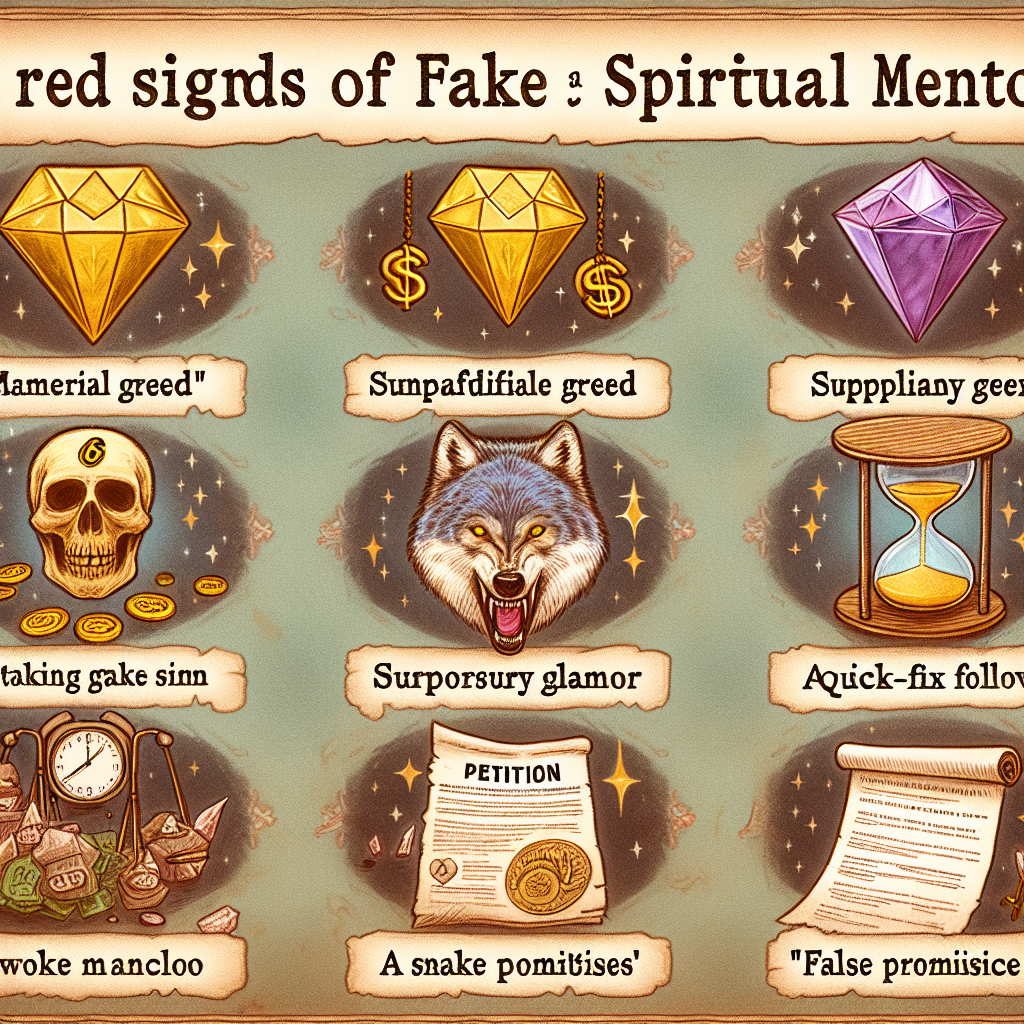-
Table of Contents
- Identifying a Fake Guru: 6 Warning Signs of a Scam
- 1. Over-the-Top Promises
- Examples of Over-the-Top Promises
- 2. Lack of Transparency
- Red Flags in Transparency
- 3. High-Pressure Sales Tactics
- Common High-Pressure Tactics
- 4. Exorbitant Fees with No Clear Value
- Indicators of Exorbitant Fees
- 5. Cult-Like Following
- Signs of a Cult-Like Following
- 6. Lack of Evidence-Based Practices
- Examples of Pseudoscientific Claims
- Case Studies: Real-Life Examples of Fake Gurus
- Case Study 1: James Arthur Ray
- Case Study 2: Elizabeth Holmes
- Statistics on Guru Scams
- Conclusion: Protecting Yourself from Fake Gurus
Identifying a Fake Guru: 6 Warning Signs of a Scam

In an age where information is at our fingertips, the rise of self-proclaimed gurus has become a double-edged sword. While some offer genuine insights and guidance, others exploit the trust of their followers for personal gain. Identifying a fake guru can be challenging, but recognizing the warning signs can save you from falling into a scam. This article delves into six critical indicators that can help you discern a genuine mentor from a fraudulent one.
1. Over-the-Top Promises
One of the most glaring signs of a fake guru is the promise of extraordinary results with minimal effort. These individuals often claim that they have discovered a secret formula or a shortcut to success that no one else knows about. While it’s natural to be drawn to the idea of quick success, it’s essential to approach such claims with skepticism.
Examples of Over-the-Top Promises
- “Make $10,000 a week with just one hour of work per day!”
- “Lose 30 pounds in 30 days without dieting or exercise!”
- “Achieve spiritual enlightenment in just one weekend!”
These promises are designed to appeal to our desire for instant gratification. However, genuine success typically requires consistent effort, time, and dedication. A legitimate guru will emphasize the importance of hard work and realistic expectations.
2. Lack of Transparency
Transparency is a hallmark of credibility. Fake gurus often operate in a shroud of secrecy, avoiding detailed explanations of their methods or qualifications. They may use vague language and buzzwords to create an illusion of expertise without providing concrete information.
Red Flags in Transparency
- Unclear or evasive answers to specific questions about their methods.
- Refusal to provide verifiable credentials or background information.
- Limited or no access to past client testimonials or case studies.
In contrast, a genuine guru will be open about their background, methods, and the results they have achieved. They will provide clear, detailed explanations and be willing to share verifiable success stories from their clients.
3. High-Pressure Sales Tactics
Fake gurus often employ high-pressure sales tactics to push their products or services. They create a sense of urgency, making you feel like you must act immediately to avoid missing out on a once-in-a-lifetime opportunity. This pressure can cloud your judgment and lead to impulsive decisions.
Common High-Pressure Tactics
- Limited-time offers with countdown timers.
- Claims that spots are filling up fast and you must act now.
- Emotional appeals that play on your fears or insecurities.
A legitimate guru will respect your decision-making process and provide you with the time and information you need to make an informed choice. They will not resort to manipulative tactics to secure a sale.
4. Exorbitant Fees with No Clear Value
While it’s reasonable for experts to charge for their services, fake gurus often demand exorbitant fees without providing clear value in return. They may offer expensive courses, seminars, or coaching programs that promise life-changing results but deliver little substance.
Indicators of Exorbitant Fees
- High upfront costs with vague descriptions of what you’ll receive.
- Pressure to upgrade to more expensive packages for “exclusive” content.
- Lack of a clear refund policy or satisfaction guarantee.
Before investing in any program, research the typical costs for similar services and compare the value offered. A genuine guru will provide a clear breakdown of what you can expect and offer reasonable pricing for their expertise.
5. Cult-Like Following
Fake gurus often cultivate a cult-like following, where their followers exhibit blind loyalty and unquestioning devotion. This environment discourages critical thinking and fosters an “us vs. them” mentality, where any dissenting opinions are dismissed or attacked.
Signs of a Cult-Like Following
- Followers who defend the guru aggressively and dismiss any criticism.
- Encouragement to cut ties with friends or family who question the guru’s teachings.
- Exclusive communities that isolate followers from outside perspectives.
A genuine guru encourages independent thought and welcomes constructive feedback. They foster a community of mutual respect and open dialogue, where followers feel empowered to question and learn.
6. Lack of Evidence-Based Practices
Finally, a key indicator of a fake guru is the reliance on pseudoscience or unproven methods. They may make grandiose claims without any scientific backing or rely on anecdotal evidence to support their teachings.
Examples of Pseudoscientific Claims
- Health products that promise miraculous cures without clinical trials.
- Financial strategies that guarantee high returns with no risk.
- Spiritual practices that claim to unlock supernatural abilities.
A legitimate guru bases their teachings on evidence-based practices and provides references to credible sources. They acknowledge the limitations of their methods and are transparent about the potential risks and benefits.
Case Studies: Real-Life Examples of Fake Gurus
To illustrate these warning signs, let’s examine a few real-life examples of fake gurus who have been exposed for their fraudulent practices.
Case Study 1: James Arthur Ray
James Arthur Ray, a self-help guru, gained fame through his appearances in “The Secret” and his seminars on personal development. However, his career took a dark turn when three participants died during a sweat lodge ceremony he conducted in 2009. Ray had promised that the ceremony would lead to spiritual breakthroughs, but his lack of proper safety measures and disregard for participants’ well-being resulted in tragedy. Ray was convicted of negligent homicide and served two years in prison.
Case Study 2: Elizabeth Holmes
Elizabeth Holmes, the founder of Theranos, claimed to have revolutionized blood testing with a device that could perform a wide range of tests with just a few drops of blood. Her charismatic persona and grand promises attracted significant investment and media attention. However, investigations revealed that the technology was flawed and unreliable. Holmes was charged with fraud, and her case serves as a cautionary tale about the dangers of believing in too-good-to-be-true claims without proper evidence.
Statistics on Guru Scams
To understand the prevalence of guru scams, let’s look at some statistics:
- A 2019 report by the Federal Trade Commission (FTC) found that Americans lost over $1.48 billion to fraud, with many scams involving self-proclaimed experts and gurus.
- A survey by the Better Business Bureau (BBB) revealed that 67% of respondents had encountered a scam related to personal development or self-help programs.
- The Association of Certified Fraud Examiners (ACFE) estimates that fraudulent schemes, including those perpetrated by fake gurus, cost businesses and individuals billions of dollars annually.
These statistics highlight the widespread impact of guru scams and the importance of being vigilant when seeking guidance from self-proclaimed experts.
Conclusion: Protecting Yourself from Fake Gurus
In conclusion, identifying a fake guru requires a critical eye and a healthy dose of skepticism. By recognizing the warning signs—over-the-top promises, lack of transparency, high-pressure sales tactics, exorbitant fees, cult-like following, and lack of evidence-based practices—you can protect yourself from falling victim to a scam.
Remember to do your research, ask questions, and trust your instincts. A genuine guru will be transparent, credible, and focused on providing real value. By staying informed and vigilant, you can navigate the world of self-help and personal development with confidence and discernment.
Ultimately, the responsibility lies with each of us to seek out authentic mentors who can genuinely guide us on our journey to success and fulfillment.








